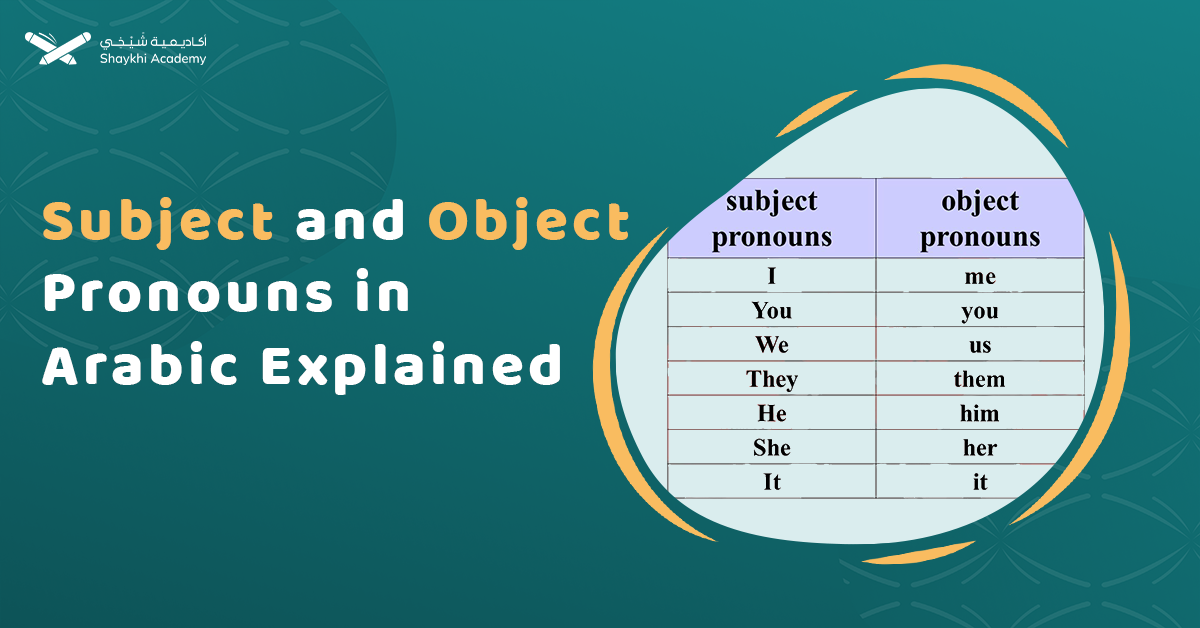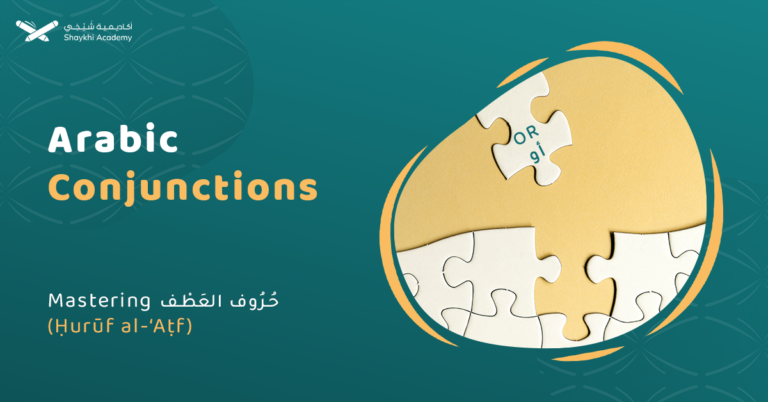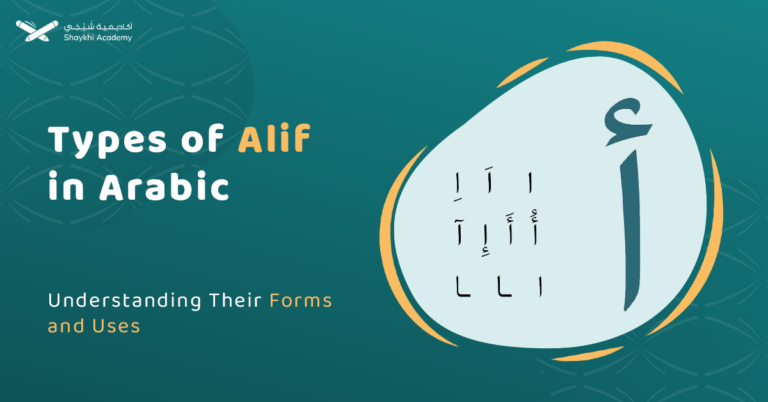Arabic subject pronouns are essential for identifying the subject of a sentence, replacing nouns and reflecting the person, gender, and number. They can be explicitly stated or understood through verb conjugation, helping convey meaning clearly and concisely in Arabic grammar.
In this in-depth article, we will cast light on the various forms and types of the Arabic subject pronouns. We will explain all the various kinds of these pronouns with a detailed description of their usages, their functions, their grammatical rules and characteristics. Go no further.
Arabic Subject Pronouns ضمائر الفاعل Damaa’ir al-Fail:
The subject pronoun in Arabic serves as a replacement for the subject of a sentence, taking on all its grammatical functions. In Arabic syntax, subject pronouns are often implied rather than explicitly stated.
This is because their presence can usually be inferred from the conjugation of the main verb in the sentence. For example, the verb’s form will indicate the gender, number, and person of the subject, making the pronoun unnecessary in most cases.
However, there are specific situations where the subject pronoun must be explicitly stated. These include instances where emphasis is required or in sentences that do not contain a main verb, such as nominal (equational) sentences. In such cases, the pronoun becomes an essential component of the sentence structure to convey meaning clearly and avoid ambiguity.
Examples of Arabic Subject Pronouns:
| English Sentence | Arabic Sentence | Transliteration | Description |
| I am from Egypt | أنَا منْ مَصر | Ana min Masr | The subject pronoun “أنا” (Ana) is explicitly stated to identify the speaker as the subject. |
| She is beautiful | هي جَميلَة | Hyya jamelah | The subject pronoun “هي” (Hyya) is explicitly stated because it is a nominal sentence. |
| You do love her | أنتْ تُحبَها | Anta tohebaha | The subject pronoun “أنت” (Anta) is explicitly stated for emphasis and clarity in this context. |
Arabic subject pronouns Chart
Here is a chart of the subject pronouns in Arabic language with a translation to their English equivalents and a description of their conjugations.
| Arabic Subject Pronouns | English Equivalent Pronouns | Verb Conjugations of Sub Pron | Congratulation Description |
| أنا | I | أُنظفُ / O’nathefo | First Person Singular |
| نحن | We | نُنَظفُ /No’nathefo | First Person Plural |
| أنتَ | You | تُنظفُ / To’nathefo | 2nd Person Singular Masculine |
| أنتِ | You | تُنظِفين /To’nathefen | 2nd Person Singular Feminine |
| أنتما | You | تُنظفانْ / To’na’thefan | 2nd Person Dual Masculine |
| أنتما | You | تُنظفانْ / To’n’thefan | 2nd Person Dual Feminine |
| أنتم | You | تُنظفون / To’na’thefoon | 2nd Person Plural Masculine |
| أنتنَ | You | تُنظفنَ / To’na’thefin | 2nd Person Plural Feminine |
| هو | He | يُنظفُ / Yo’na’thef | 3rd Person Singular Masculine |
| هي | She | تُنظفُ / To’na’thef | 3rd Person Singular Feminine |
| هما | They | يُنظفانْ / Yo’na’thefan | 3rd person Dual masculine |
| هما | They | تُنظفان / To’na’thefan | 3rd person Dual Feminine |
| هم | They | يُنظفون / Yo’na’thefoon | 3rd person Plural Masculine |
| هن | They | يُنظفْن / Yo’na’thefin | 3rd person Plural Feminine |
Arabic Subject Pronouns List With Examples
Subject pronouns are of various kinds, each kind of them should cope with the sentence main verb that precedes it. Check Shaykhi Academy’s Learn Arabic Online Course for more details.
In this section, we will render all the subject pronouns with a complete demonstration for each kind in detail, attached with illustrative examples. We will also explain the difference between each pronoun and the closest pronoun to it in terms of meaning, usage, and function. Let’s start.
1. The Arabic Subject Pronouns [I / أنا]
The subject pronoun (أنا / Ana) is the first pronoun in the subject pronoun cluster. It is used to refer to the first-person singular, (Dameer al-Motikalem). The subject pronoun (أنا / Ana) can be Apparent or hidden in an Arabic sentence.
Pay attention to the initials or words in the following examples: –
| English Sentence | Arabic Sentence | Transliteration | Description |
| I love apples | أُحبُ التُفاحَ | O’heb’bo at-Tofaha | The subject pronoun “أنا” (Ana) is implied in the verb “أُحبُ” (O’heb’bo), as verb conjugation identifies the subject. |
| I am happy | أَنْا سَعيدٌ | Ana sa3edon | The subject pronoun “أنا” (Ana) is explicitly stated to indicate the speaker’s state clearly in this nominal sentence. |
Note: – The above first sentence contains a main verb. So the subject pronoun (أنا / Ana) is hidden Or rather, to be more precise, it was shortened, leaving only the first letter, which is al-Alf (أ). Whereas the above second sentence does not contain a main verb. So the subject pronoun (أنا / Ana) is apparent.
2. The Arabic Subject Pronouns [We / نحن]
The subject pronoun (نحن / Nahno) is the second pronoun in the subject pronouns cluster. It is used to refer to the first-person plural, (Dameer al-Motikalem). It can be Apparent or hidden in an Arabic sentence.
Pay attention to the initials or words in the following examples:
| English Sentence | Arabic Sentence | Transliteration | Description |
| We are honorable | نَحنُ شُرَفاءُ | Nahno shorafaeo | The subject pronoun “نَحنُ” (Nahno) is explicitly stated in this nominal sentence for emphasis on the subject “we.” |
| We love Islam | نُحبُ الإسْلامَ | Nohebo il-Islam | The subject pronoun “نَحنُ” (Nahno) is implied in the verb “نُحبُ” (Nohebo), as the conjugation indicates the plural subject. |
3. The Arabic Subject Pronouns [You – You / أنتَ – أنتِ]
The subject pronoun [Anta – Antee / أنتْ – أنتِ] are the third and fourth pronouns in the subject pronouns cluster. They both refer to the second person singular, (Dameer al-Mokhatib). The pronoun (أنتَ / Anta), – pay attention to the fat’ha mark above the final letter- is a masculine pronoun. Whereas the pronoun (ِأنت / Antee), -pay attention to the kasrah mark under the final letter- is a feminine pronoun. They both can be Apparent or hidden in an Arabic sentence.
Pay attention to the initials or words in the following examples: –
| English Sentence | Arabic Sentence | Transliteration | Description |
| You are a smart boy. | أَنت وَلدٌ ذَكيٌ | Anta waladon zakeyon | The subject pronoun “أَنت” (Anta) is explicitly used here to emphasize the addressee (a boy). |
| You are a beautiful girl. | أَنْتِ بنْتٌ جَميلةٌ | Antee benton jamelaton | The feminine form “أَنْتِ” (Antee) is used to address a girl explicitly, paired with feminine nouns and adjectives. |
| Shut up, boy. | أُسكُت، يا وَلْد | Oskot ya walid | The verb “أُسكُت” (Oskot) is imperative for a male, and the vocative particle “يا” (ya) specifies the addressee. |
| Shut up, girl. | أُسْكُتي يا بنتْ | Oskotee ya bent | The verb “أُسْكُتي” (Oskotee) is the feminine imperative form, used when addressing a girl. |
Notes:
▪︎ When the pronoun (أَنْتَ) or (أنتِ) is hidden, it is shortened, leaving only its first letter, al-Alf (أ) to be attached as a prefix at the beginning of the sentence’s main verb.
▪︎ With the second person singular feminine, we add the feminine ya’a (ي) at the end of the sentence’s main verb.
4. The Arabic Subject Pronouns [You – You – You / أنتما – أنتم – أنتن]
The subject pronoun [Antoma – Antom – Anton / أنتما – أنتم – أنتن] are the second person dual and plural pronouns, (Dama’ir al-Mokhatib). The pronoun (أنتما / Antoma), is a dual masculine and feminine pronoun. Whereas the pronoun (ِأنتم / Antom), is a plural masculine pronoun, and the pronoun (ِأنتنَ / Anton), is a plural feminine pronoun. All the above-mentioned pronouns can be apparent or hidden in an Arabic sentence.
Pay attention to the initials or words in the following examples:
| English Sentence | Arabic Sentence | Transliteration | Description |
| You are two smart boys. | أَنْتُما وَلَدان ذَكيْان | Antoma waladan zakeyan | The dual subject pronoun “أَنْتُما” (Antoma) is used for addressing two boys, paired with dual nouns and adjectives. |
| You are two beautiful girls. | أًنْتُما بنْتان جَمْيلتَان. | Antoma bentan jameeltan | The dual feminine pronoun “أَنْتُما” (Antoma) applies here, with the dual form of feminine nouns and adjectives. |
| Shut up, two boys. | أُصْمُتا، يا ولَدان. | Osmota ya waladan | The dual imperative verb “أُصْمُتا” (Osmota) is used for addressing two males, with the vocative “يا”. |
| Shut up, two girls. | أُصْمُتا يَا بنْتان. | Osmota ya bentan | The same dual imperative verb “أُصْمُتا” (Osmota) is applied, but directed at two females. |
| Listen, guys. | أَصْغوا يا شَبَاب. | Asghoo ya shabab | The plural imperative “أَصْغوا” (Asghoo) is used for a group, with “شَبَاب” (shabab) specifying young men. |
| You are brave men. | أَنْتُم رجَالٌ شُجعَانٌ. | Antom rejalon shog3anon | The plural pronoun “أَنْتُم” (Antom) addresses a group of men, paired with plural nouns and adjectives. |
| You are kind girls. | أَنتُنّ بَناتٌ طَيبْاتٌ. | Anton banaton tiyabaton | The plural feminine pronoun “أَنتُنّ” (Anton) is used for addressing a group of girls. |
Notes:
- In the English language, it is only one second-person pronoun, “You”, which is used to indicate singular, dual, or plural; masculine or feminine. Whereas, in Arabic language, it is not only one second-person pronoun, they are more than one and of different kinds, singular, dual, plural; masculine and feminine.
- The pronoun (أَنتَ) is used when we’re addressing a singular masculine. Whereas (أَنتِ) is used for a singular feminine, and (أنتمُا) is used for dual both masculine and feminine, and (أنتُم) is for plural masculine. And finally, (أنتُن) is used for plural feminine.
- You should pay attention to the dual alif (ا) that is attached to the end of the main verb when the sentence subject pronoun (أنتما) is hidden as mentioned in example number “3”.
- You should pay attention to the plural waw (وا) that is attached to the end of the main verb when the sentence subject pronoun (أنتم) is hidden, as mentioned in example number “5”.
5. The Arabic Subject Pronouns [He- She – They – They – They / هو – هي – هما – هم – هن]
The subject pronouns
[Hwa – Hya- Homa – Hom – Hon / هو – هي – هما- هم- هن] are the third person singular, dual and plural pronouns, (Dama’ir al-Gha’eb). The subject pronoun (هو / Hwa), is a third person singular masculine. The pronoun (هي / Hya) is a third person singular feminine, Whereas the pronoun (هما / Homa), is a third person dual pronoun for both masculine and feminine, and the pronoun (ِهم / Hom), is a third person pronoun for plural masculine, and (ِهن / Hon), is a third person pronoun for plural feminine, All the above-mentioned pronouns can be apparent or hidden in an Arabic sentence.
Pay attention to the initials or words in the following examples: –
| English Sentence | Arabic Sentence | Transliteration | Pronoun Type | Description |
| He is a doctor. (Apparent) | هوَ دُكتور. | Hwa doctor | Apparent Singular | The subject pronoun “هوَ” (Hwa) is explicitly stated, referring to a male. |
| He watched TV. (Hidden) | شَاهَدَ التِلفَاز. | Shahada el-Telfaz | Hidden Singular | The subject pronoun is implied in the verb conjugation for masculine singular. |
| She is sad. (Apparent) | هيَ حَزينة. | Hya hazenah | Apparent Singular | The subject pronoun “هيَ” (Hya) is explicitly stated, referring to a female. |
| She traveled yesterday. (Hidden) | سَافَرتْ بالأَمسِ | Safarit bel-Amiss | Hidden Singular | The subject pronoun is implied in the verb conjugation for feminine singular. |
| They’re two smart boys. (Apparent) | هُما وَلَدان ذَكيْان | Homa waladan zakeyan | Apparent Dual | The dual subject pronoun “هُما” (Homa) is explicitly stated for two males. |
| They’re two cute girls. (Apparent) | هُما بنْتان جَمْيلتَان. | Homa bentan jamelatan | Apparent Dual | The dual subject pronoun “هُما” (Homa) is explicitly stated for two females. |
| They both watched TV. (Hidden) | شَاهَدا التِلفازَ. | Shahada al-telfaz | Hidden Dual Masculine | The dual masculine pronoun is implied in the verb conjugation. |
| They both watched TV. (Hidden) | شَاهَدتا التِلفازَ. | Shahadata al-telfaz | Hidden Dual Feminine | The dual feminine pronoun is implied in the verb conjugation. |
| They are happy men. (Apparent) | هُم رِجالٌ سعداءٌ | Hom rejalon so3adaon | Apparent Plural | The plural subject pronoun “هُم” (Hom) is explicitly stated for a group of men. |
| They all watched TV. (Hidden) | شَاهَدوا التِلفازَ | Shahado al-telfaz | Hidden Plural Masculine | The plural masculine pronoun is implied in the verb conjugation. |
| They are poor women. (Apparent) | هُن نِساءٌ فقِراتٌ. | Hon nesaon faqerat | Apparent Plural | The plural feminine subject pronoun “هُن” (Hon) is explicitly stated for a group of women. |
| They watched TV. (Hidden) | شَاهَدنَ التِلفازَ | Shahadin al-telfaz | Hidden Plural Feminine | The plural feminine pronoun is implied in the verb conjugation. |
| They are brave men. (Apparent) | هُم رجَالٌ شُجعَانٌ | Hom rejalon shog3anon | Apparent Plural | The plural masculine pronoun “هُم” (Hom) is explicitly stated for a group of men. |
| They are kind girls. (Apparent) | هُن بَناتٌ طَيباتٌ. | Hon Banaton taybaton | Apparent Plural | The plural feminine pronoun “هُن” (Hon) is explicitly stated for a group of girls. |
Notes:
- In the English Language, there is only one third-person pronoun for plural, “They” which is used to indicate, dual, or plural masculine or feminine. Whereas, in Arabic language, there are more than one, and they are of different kinds, dual, plural masculine and feminine. The pronoun (هما) is used when we’re referring to dual masculine or dual feminine. The pronoun (هم) is used for plural masculine, and finally, the pronoun (هن) is used for plural feminine.
- In the example number “10”, the plural waw (وا) is attached to the end of the main verb when the sentence subject pronoun (أنتم) is hidden.
- In the example number “12”, Noon an-Neswa (ن) is attached to the end of the sentence’s main verb when the subject pronoun (هن) is hidden. Visit Shaykhi Academy’s page to check General Arabic Course for more details about this point.
Compare Arabic Subject Pronouns With The Arabic Object Pronouns:
Arabic subject and object pronouns are essential elements of sentence structure, reflecting the gender, number, and grammatical roles of subjects and objects. The table below summarizes their primary forms and usage for learners.
| Type | Explanation | Example | Translation |
| Subject Pronouns | Replace the sentence’s subject, aligning with gender, number, and verb conjugations. Can be apparent or hidden. | أنا سعيدٌ (Ana sa’idun) | I am happy |
| أحب التفاح (O’hebbo at-Tofaha) | I love apples | ||
| Object Pronouns | Replace the object of a sentence and appear as suffixes attached to verbs, reflecting the object’s characteristics. | ساعدنا المعلم (Sa’adana al-Mo’allem) | The teacher helped us |
| أحببتها (Ahbabtaha) | I loved her |
For a detailed breakdown of these pronouns and their grammatical functions, Shaykhi Academy offers in-depth lessons with practical examples.
Read more about: Arabic Object Pronouns ضمائر المفعول “Damaa’ir al-Maf3uul” With Examples And Charts
Start Your Worthwhile Journey of Learning Arabic Subject Pronouns with Shaykhi Academy
Shaykhi Academy presents large sets of enhanced grammatical theories and rules about the affluence and abundance of the Arabic language.
Shaykhi Academy’s Online Fusha Arabic Course To Learn Modern Standard Arabic is a unique course for all those who aspire to master the Arabic language. The course covers many essential language syntaxes and semantics about all kinds of the Arabic subject pronouns. It also deals with additional grammatical thoughts and points of view.
Shaykhi Academy’s all-inclusive lessons present immersive educational knowledge tailored professionally to attract the learners’ admiration.
Shaykhi Academy’s Online Fusha Arabic Course To Learn Modern Standard Arabic is taught under the auspices of the experienced tutors Dr. Mahmoud AlAssal and Sh. Luqman ElKasabany.
All Shaykhi Academy staff are graduates of Al-azhr Ash-Sharif University. They had professional experiences in the Arabic language teaching field. It is an essential matter to be taught under the aegis of such quality.
Why Shaykhi Academy?
- Expert Native Tutors: Learn from highly qualified native Arabic speakers.
- Flexible Scheduling: Tailor your classes to fit your busy life.
- Affordable Learning: Access top-quality education at a price that suits you.
- Global Access: Study from anywhere in the world.
Explore Our Arabic Courses:
- Noorani Qaida: Build a strong foundation in Quranic Arabic.
- Comprehensive Arabic Courses: Master the Arabic language, from beginner to advanced levels.
- Fusha Arabic Classes: Delve into Modern Standard Arabic, the key to understanding literature, media, and formal communication across the Arab world.
- Quranic Arabic Course: Enhance your connection with the Quran by learning the language in which it was revealed.
Start Your Arabic Journey Today! Whether you’re just starting or looking to deepen your knowledge, Shaykhi Academy is here to support your journey. Book your free trial now and begin your path to Arabic mastery!
Conclusion
Arabic subject pronouns serve as vital tools for sentence construction, replacing subjects and aligning with verb conjugations to reflect gender, number, and person. While often implied through verb forms, they are explicitly stated for clarity in nominal sentences or emphasis. Examples include “أنا” (Ana) for “I” and “هي” (Hya) for “she.” Shaykhi Academy offers an in-depth exploration of these pronouns, highlighting their grammatical functions and usage nuances.















































